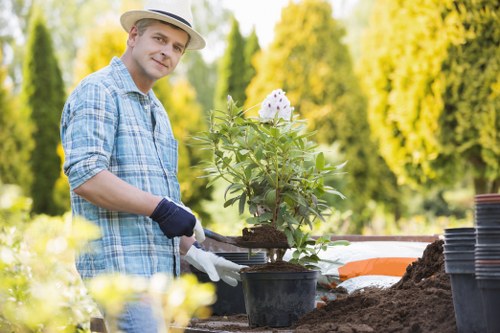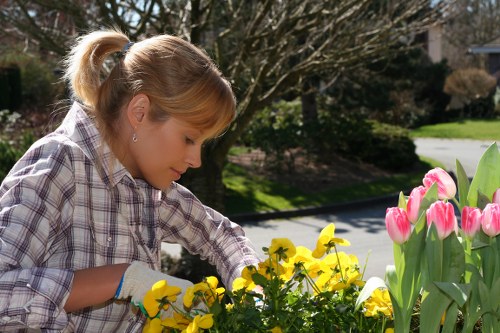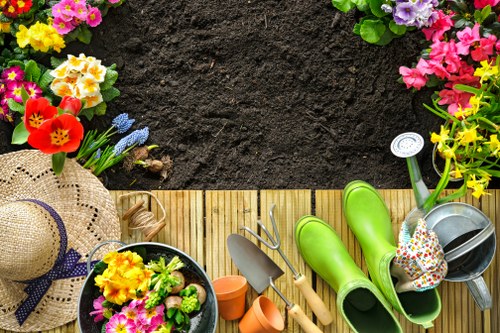Comprehensive Guide to Garden Maintenance in Cleaners E9
Introduction to Garden Maintenance

Maintaining a beautiful garden in Cleaners E9 requires a blend of knowledge, effort, and the right tools. Whether you’re a seasoned gardener or a beginner, understanding the fundamentals of garden maintenance can transform your outdoor space into a vibrant and inviting retreat.
Garden maintenance not only enhances the aesthetic appeal of your property but also promotes a healthy ecosystem. Regular upkeep ensures that plants thrive, pests are managed, and the overall environment remains balanced.
In this guide, we’ll explore various aspects of garden maintenance tailored specifically for Cleaners E9, helping you achieve a lush and well-kept garden all year round.
Essential Tools for Garden Maintenance

Having the right tools is crucial for effective garden maintenance. Investing in quality equipment can make tasks easier and more efficient, allowing you to focus on creating a beautiful garden.
Here are some essential tools every gardener in Cleaners E9 should have:
- Pruning Shears: Ideal for trimming and shaping plants.
- Garden Fork: Perfect for loosening soil and removing weeds.
- Watering Can: Ensures plants receive adequate moisture.
- Gloves: Protect your hands from thorns and dirt.
- Lawn Mower: Keeps your grass neat and tidy.
Investing in these tools will not only enhance the efficiency of your garden maintenance routine but also improve the overall health and appearance of your garden.
Soil Preparation and Maintenance

Healthy soil is the foundation of a thriving garden. Proper soil preparation and maintenance ensure that plants have the necessary nutrients to grow and flourish.
Start by testing your soil to determine its pH level and nutrient content. This information will help you amend the soil appropriately, whether it needs more lime to reduce acidity or additional compost to increase fertility.
Regularly aerate the soil to improve drainage and promote root growth. Incorporating organic matter like compost or well-rotted manure can enhance soil structure and provide essential nutrients to plants.
Plant Selection and Care

Choosing the right plants is key to successful garden maintenance. Consider the climate, soil type, and sunlight availability in Cleaners E9 when selecting plants.
Opt for native species as they are adapted to the local environment and require less maintenance. Additionally, diversifying your plant selection can attract beneficial insects and promote a balanced ecosystem.
Watering Techniques
Proper watering is vital for plant health. Water your garden early in the morning or late in the evening to minimize evaporation and ensure that plants receive adequate moisture.
Using drip irrigation systems can provide a consistent water supply directly to the plant roots, reducing water wastage and preventing fungal diseases caused by excessive moisture on leaves.
Pest and Disease Management

Effective pest and disease management is essential to maintain a healthy garden. Regularly inspect your plants for signs of pests or diseases and take prompt action to address any issues.
Adopt integrated pest management (IPM) practices, which combine biological, cultural, and chemical methods to control pests with minimal environmental impact.
Encourage beneficial insects like ladybugs and lacewings that prey on common garden pests. Applying organic pesticides as a last resort can help manage outbreaks without harming beneficial organisms.
Preventive Measures
Preventing pests and diseases is more effective than treating them after they appear. Practice crop rotation, maintain plant hygiene, and avoid overwatering to reduce the risk of infestations.
Lawn Care and Maintenance
Maintaining a lush lawn requires consistent care and attention. Here are some key practices:
Regular mowing helps keep the grass at an optimal height, promoting dense growth and reducing weed invasion. Ensure your mower blades are sharp to make clean cuts that minimize stress on the grass.
Fertilizing your lawn in the spring and fall provides essential nutrients that support healthy growth. Choose a fertilizer appropriate for the grass type in your Cleaners E9 garden.
Aerating the lawn yearly improves soil compaction, allowing air, water, and nutrients to penetrate deeper into the soil and reach the grass roots effectively.
Weed Control
Weeds compete with your grass for nutrients and water, making regular removal crucial. Hand-pulling or using a hoe can effectively manage weed growth without the need for harsh chemicals.
Applying mulch around plants and garden beds can suppress weed growth while retaining soil moisture and enhancing the garden’s appearance.
Seasonal Garden Maintenance
Different seasons bring unique challenges and opportunities for garden maintenance in Cleaners E9. Adapting your maintenance practices to the changing seasons ensures year-round garden health and beauty.
Spring: Focus on planting new flowers and vegetables, pruning perennials, and preparing flower beds by adding compost.
Summer: Maintain regular watering schedules, manage pests, and mulch garden beds to conserve moisture.
- Pruning shrubs to promote airflow and reduce disease risk.
- Deadheading flowers to encourage continuous blooming.
- Harvesting ripe vegetables and fruits to enjoy their freshness and prevent overripe produce from attracting pests.
Hardscaping and Garden Structures
Integrating hardscaping elements can enhance both the functionality and aesthetics of your garden. Consider incorporating:
Stone pathways that provide easy access to different garden areas while adding visual interest.
Garden sheds for storing tools and equipment, keeping your maintenance materials organized and protected.
Fencing to create defined spaces and provide privacy, as well as trellises for climbing plants to add vertical dimension to your garden.
Outdoor Lighting
Installing outdoor lighting can extend the usability of your garden into the evening hours. Solar-powered lights are an eco-friendly option that illuminates pathways and highlights garden features without increasing your energy bill.
Composting and Soil Health
Composting is a sustainable way to recycle garden waste and produce rich organic matter for your soil. A well-maintained compost pile provides nutrients that improve soil structure and fertility.
To create an effective compost, combine green materials like vegetable scraps and grass clippings with brown materials such as dry leaves and branches. Regularly turning the compost pile accelerates decomposition and prevents unpleasant odors.
Incorporating compost into your garden beds enhances soil health, promotes robust plant growth, and reduces the need for chemical fertilizers.
Mulching Benefits
Mulching helps conserve soil moisture, suppress weeds, and regulate soil temperature. Organic mulches, such as bark, straw, or compost, add nutrients to the soil as they decompose.
- Benefits of Mulching:
- Retains moisture during dry periods.
- Prevents weed seeds from germinating.
- Enhances the visual appeal of garden beds.
- Types of Mulch:
- Organic mulches like wood chips and leaves.
- Inorganic mulches such as gravel and rubber.
Pruning and Trimming Techniques
Pruning is essential for maintaining plant health and encouraging vigorous growth. It involves removing dead or diseased branches and shaping plants to enhance their appearance.
Different plants require different pruning techniques. For example, flowering shrubs like rhododendrons are best pruned immediately after blooming, while fruit trees benefit from late winter pruning to promote fruit production.
Proper Pruning Tools
Using the right tools ensures clean cuts that minimize damage to plants. Sharp pruning shears and loppers are essential for precision and efficiency.
Regularly disinfect your tools to prevent the spread of diseases between plants. Always make cuts at a slight angle to facilitate healing and reduce the risk of infection.
Irrigation Systems and Water Conservation
Efficient irrigation is vital for maintaining a healthy garden. Implementing water-saving techniques can reduce your water bill and promote sustainable gardening practices.
Drip irrigation systems deliver water directly to plant roots, minimizing evaporation and ensuring plants receive the required moisture without wastage.
- Advantages of Drip Irrigation:
- Reduces water usage by up to 50% compared to traditional sprinklers.
- Prevents waterlogging and root rot.
- Targets specific areas, allowing for precise watering.
- Rainwater Harvesting: Collecting rainwater in barrels can provide a free and natural source of water for your garden, especially during dry spells.
Incorporating mulch around plants can further enhance water retention, reducing the frequency of watering sessions required.
Fertilization Strategies
Proper fertilization supports plant growth and boosts resistance to pests and diseases. Understanding the nutritional needs of your plants is essential for effective fertilization.
Use a balanced fertilizer that provides essential nutrients like nitrogen, phosphorus, and potassium. Organic fertilizers, such as compost and bone meal, offer a slow-release option that improves soil health over time.
Avoid over-fertilizing, which can lead to nutrient runoff and environmental pollution. Follow the recommended application rates to ensure plants receive the appropriate amount of nutrients without adverse effects.
Timing of Fertilization
Apply fertilizers during the active growing seasons—spring and early summer—for maximum effectiveness. Late-season fertilization can promote tender new growth that is susceptible to winter damage.
- Spring: Boosts growth after winter dormancy.
- Autumn: Prepares plants for upcoming colder months.
Lawn Aeration and Overseeding
Lawn aeration involves perforating the soil with small holes to allow air, water, and nutrients to penetrate the grass roots. This process alleviates soil compaction and promotes a healthier lawn.
Overseeding complements aeration by introducing new grass varieties that fill in bare spots and enhance lawn density. Selecting a grass type suited to Cleaners E9’s climate ensures optimal growth and resilience.
Benefits of Aeration and Overseeding
- Improved Root Growth: Encourages deeper root systems for stronger plants.
- Enhanced Soil Health: Facilitates better nutrient absorption and water retention.
- Weed Reduction: Thick, healthy lawns outcompete weeds naturally.
Regular aeration and overseeding contribute to a lush, resilient lawn that remains green and vibrant throughout the year.
Garden Lighting and Ambiance
Enhancing your garden with proper lighting can create a stunning nighttime ambiance and improve safety around your property.
Incorporate a mix of ambient, task, and accent lighting to highlight garden features such as pathways, plants, and outdoor seating areas.
Types of Garden Lighting
- Solar-Powered Lights: Eco-friendly options that harness sunlight during the day to illuminate your garden at night.
- LED Fixtures: Energy-efficient and long-lasting, suitable for various lighting needs.
- String Lights: Perfect for creating a cozy and inviting atmosphere in outdoor living spaces.
Strategically placed lighting not only enhances the beauty of your garden but also provides safety and security by illuminating dark areas and deterring unwanted visitors.
Sustainable Gardening Practices
Adopting sustainable gardening practices benefits both your garden and the environment. By minimizing waste and conserving resources, you contribute to a healthier ecosystem.
Here are some sustainable gardening tips for Cleaners E9:
- Composting: Recycle organic waste to create nutrient-rich compost for your garden.
- Water Conservation: Implement efficient irrigation systems and use mulch to retain soil moisture.
- Native Plant Selection: Choose plants adapted to the local climate, requiring less water and maintenance.
- Organic Pest Control: Use natural methods to manage pests, reducing reliance on chemical pesticides.
Integrating these practices ensures a sustainable, low-maintenance garden that thrives with minimal environmental impact.
Benefits of Sustainable Gardening
Sustainable gardening promotes biodiversity, reduces resource consumption, and creates a harmonious balance between human activity and nature.
Creating a Year-Round Maintenance Schedule
Establishing a maintenance schedule helps keep your garden in pristine condition throughout the year. By planning tasks according to the seasons, you can address issues proactively and ensure consistent care.
Here’s a sample year-round garden maintenance schedule for Cleaners E9:
- Spring: Plant new flowers, prune shrubs, fertilize soil, and start composting.
- Summer: Maintain watering routines, manage pests, deadhead flowers, and mow the lawn regularly.
- Autumn: Clear fallen leaves, prepare plants for winter, aerate the lawn, and overseed grass.
- Winter: Protect sensitive plants, plan garden layouts for the upcoming year, and perform tool maintenance.
Adhering to a structured maintenance schedule ensures that your garden remains healthy and beautiful, regardless of the season.
Tracking Your Progress
Keep a gardening journal to monitor plant growth, record maintenance tasks, and note any issues that arise. This practice helps you identify patterns, adjust strategies, and improve your garden maintenance efforts over time.
Conclusion
Effective garden maintenance in Cleaners E9 involves a combination of proper planning, the right tools, and sustainable practices. By following the guidelines outlined in this guide, you can cultivate a thriving garden that enhances your property’s beauty and provides a peaceful outdoor oasis.
Remember, a well-maintained garden not only offers aesthetic pleasure but also contributes to environmental sustainability and personal well-being. Start implementing these practices today to enjoy a lush and vibrant garden all year round.
Contact us today to learn more about professional garden maintenance services tailored to your needs in Cleaners E9.


